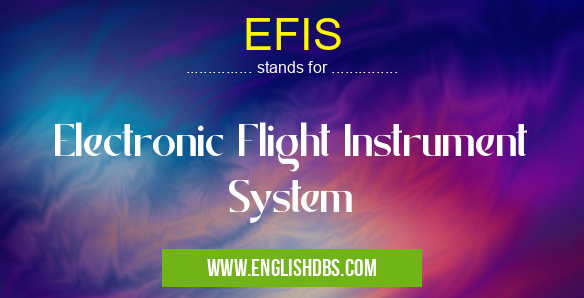What does EFIS mean in AIRCRAFT & AVIATION
An Electronic Flight Instrument System (EFIS) is an avionics system that displays in-flight information to pilots and crew in a digital format. It is designed to improve safety, navigation accuracy, and situational awareness by providing visual representations of the flight profile and environmental conditions. This device can also be used to provide warnings when hazardous situations arise. EFIS systems have become commonplace on modern aircraft, allowing pilots the ability to monitor and control multiple aspects of their aircraft while in flight.

EFIS meaning in Aircraft & Aviation in Miscellaneous
EFIS mostly used in an acronym Aircraft & Aviation in Category Miscellaneous that means Electronic Flight Instrument System
Shorthand: EFIS,
Full Form: Electronic Flight Instrument System
For more information of "Electronic Flight Instrument System", see the section below.
What does EFIS mean?
The acronym "EFIS" stands for Electronic Flight Instrument System. This system was created as a way of giving pilots access to more accurate data than what traditional analog instruments had provided in the past. An EFIS simplifies the cockpit environment by replacing multiple dials and gauges with digital readouts. The EFIS display usually consists of several different screens that are tailored to the specific model of aircraft being flown. The pilot has access to information such as airspeed, altitude, heading, fuel levels, engine performance parameters, and GPS navigation guidance all at one glance on their screens. Additionally, an EFIS can provide visual and auditory alerts when dangerous situations arise or when pre-programmed limits are exceeded.
Essential Questions and Answers on Electronic Flight Instrument System in "MISCELLANEOUS»AIRCRAFT"
What is an EFIS?
EFIS stands for Electronic Flight Instrument System, and it is a type of aircraft avionics suite that displays flight data on a display unit. It generally includes an Electronic Attitude Director Indicator (EADI), Electronic Horizontal Situation Indicator (EHSI), Digital Air Data Display (DADD), Multifunction Control and Display Unit (MCDU) or other components.
What are the benefits of using an EFIS?
An EFIS offers a variety of benefits to pilots, including improved situational awareness as well as increased safety and reliability through more accurate information presented digitally compared to analog instruments. Additionally, it reduces pilot fatigue and workload with features such as automated navigation solutions.
Is an EFIS required to fly?
No, an EFIS is not strictly required for flight operations but can greatly improve the quality and efficiency of many operations depending on the aircraft type, mission requirements and pilot experience level. Generally speaking, unless otherwise specified by regulations or procedures, most civilian aircraft types may be operated without an EFIS installed.
How does an EFIS work?
An EFIS works by taking data from various sensors on board the aircraft which is then processed by a computer which displays relevant information such as airspeed, altitude, heading and track on a display unit. The sensors often include air pressure transmitters known as pitot tubes which measure airspeed relative to ambient static pressure; gyroscopes which measure attitude; global positioning system receivers which provide precise position information; radio altimeters for measuring altitude above ground level; inertial navigation systems that track acceleration changes over time; Doppler radar for measuring in-flight speed; magnetometers used in autopilot systems; and other types of sensors that detect wind direction & speed.
What types of aircraft use EFIS?
Most commercial airliner types today employ some form of an electronic flight instrument system, ranging from basic partial electronic flight instrument systems found in smaller general aviation aircraft all the way up to sophisticated fully-integrated shared cockpit avionics suites found in modern jetliners.
Is there any difference between EFI and EFIS?
Yes! While both terms refer to different aspects of flight instrumentation technology they essentially have different meanings. EFI stands for "Engine Flight Instruments" while EFIS refers specifically to Electronic Flight Instrument Systems — a more advanced type of onboard electronics suite developed within the past several decades for commercial airplanes & other large passenger jets used throughout the world today.
How much does an average Electronic Flight Instrument System cost?
Generally speaking prices vary quite significantly depending on size & complexity – ranging anywhere from several thousand dollars up to millions depending on factors such as manufacturer model type /specific applications etc., so it really depends upon your specific requirements.
Final Words:
Overall, the Electronic Flight Instrument System (EFIS) is a significant advance over older analog instrumentation systems that has made life much easier for pilots all around the world. By providing comprehensive and accurate information in an easy-to-read digital format on large visible displays, pilots can now monitor various parameters during flight without having to take their eyes off the cockpit environment for too long – significantly improving safety outcomes in both commercial and recreational flying scenarios.
